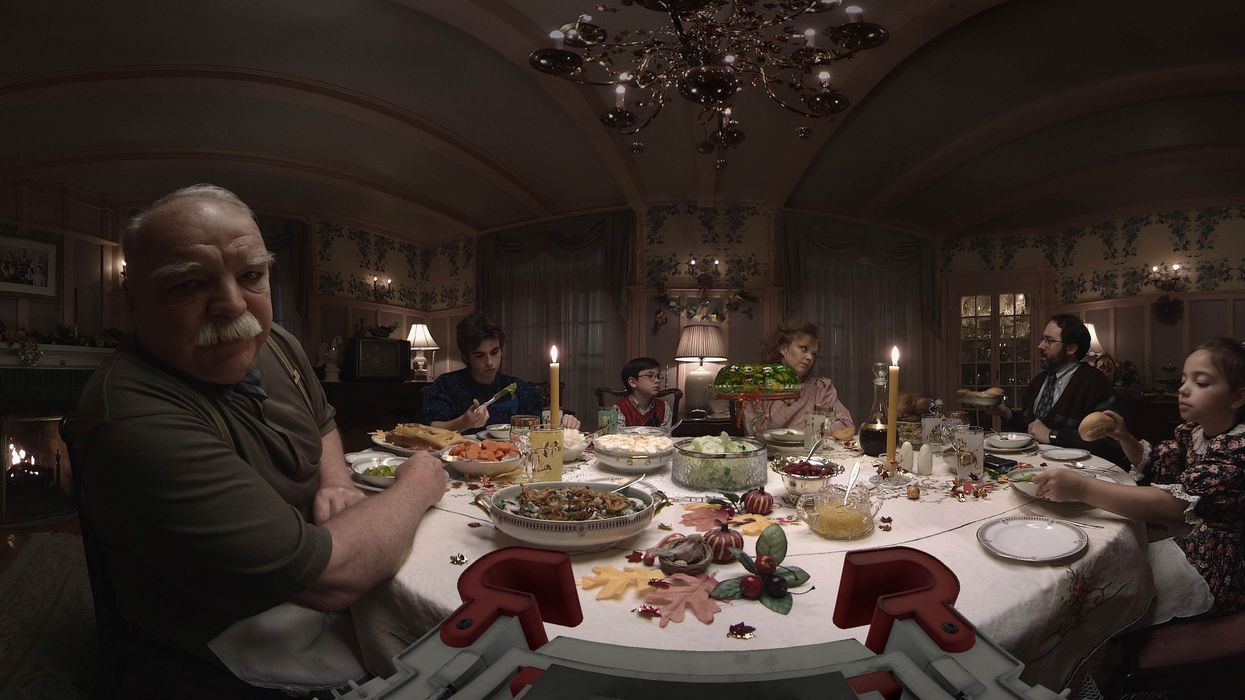Think Classic Cinema Doesn't Translate to VR? Here's How to Bring 3-Act Structure to 360
"We're leveraging several thousand years of history and classical storytelling. It's kind of our DNA."

Many filmmakers are skeptical about virtual reality's ability to convey a story like a traditional film can. There are no shots. There are no cuts. So how can it? Some Sundance filmmakers found success this year by employing a time-tested cinematic technique: a traditional character arc.
At the 2017 Sundance Film Festival, Félix Lajeunesse and Paul Raphaël of Felix & Paul Studios unveiled their 40 minute VR comedy Miyubi and Maureen Fan, Kane Lee, and Eric Darnell (Madagascar) of Baobab Studios premiered their animated VR film, ASTEROIDS! They joined a panel discussion titled Pushing the Creative Frontiers in VR Filmmaking to share what they have figured out. Below are our biggest takeaways on how and why you should consider merging VR with a traditional story arc.

Create a VR three-act structure by mimicking the human brain
At the premiere of ASTEROIDS! (an alien space journey where you can play with your pet robot dog), Eric Darnell, the director behind DreamWorks Animation's Madagascar films, told No Film School that story structure is crucial to VR.
"While storytelling may vary from film to television to theater to literature, there's always this overarching structure," said Darnell. "The toolkit is different in each medium, but they're serving the same higher goal. That's how I look at it here. We're leveraging several thousand years of history and classical storytelling. It's kind of our DNA. We have a different toolkit, but we keep our eyes on the prize of having a great story and telling it well. And having likeable characters."
"You release cortisol, a stress hormone, or oxytocin, a love hormone, at certain times that mimic the three-act structure."
During the panel discussion, Fan added that the three-act structure in VR may even stem from a biological need. "Your body releases chemicals at certain moments during a movie," said Fan. "You release cortisol, a stress hormone, or oxytocin, a love hormone, at certain times that mimic the three-act structure. We have to pay attention to that." Kane agreed. "Story evolved into our DNA for a reason."
Use disruption to prevent VR performances from going stale
Something about the immersive environment of VR can make the acting seem...bad! Terrible acting is prevalent in narrative VR these days, which can make it difficult to relate to the characters. There's a reason for that, according to Paul Raphaël, and a way to try to avoid it.
"VR comes with more verisimilitude," said Raphaël. "With film there is more abstraction from reality because of cutting between different shots at different lenses. Because VR is closer to what you see in reality, you are more critical of what you are seeing. You can detect any false notes and fakeness. The best way we've found to counter this is to leave space for mistakes when you are writing." Lajeunesse added to his collaborator's assertions. "On Miyubi, we would tell actors to disrupt the scene, so everyone has an authentic reaction. We strategically added some errors that can't be faked."

"Because VR is closer to what you see in reality, you are more critical of what you are seeing. You can detect any false notes and fakeness."
Script & storyboard with 360 in mind
All the creators agreed emphatically that new solutions were needed to write for narrative VR with a proper story arc.
"In fiction VR, we write like cinema," said Lajeunesse, whose film Miyubi places the viewer into the perspective toy robot in a tumultuous 1980s family home. "The difference is we take away the lexicon of cinema. When ready, we transfer the story to a 360 storyboard. We do a birds' eye view, we animate little dots, and craft the staging this way. That's a form of writing for us."

Keep your mind open to interactivity, even if it doesn't fully work yet
Let's face it, a lot of VR interactivity feels a little hokey right now. But that could be changing.
"We want to merge game and film in the right way," said Fan, who comes from a gaming background. "When you're playing a game, right away you think, what does the game-maker want me to do now? We don't want that. So we looked into science of how to connect you to a character. We started with a robot dog who will mirror you, to get you to bond with it. "
Paul Raphaël agreed that there are difficulties at this stage. "We hadn't jumped into [interactivity] earlier because of the chasm between game and story. You get the feeling you are in a game, where these are the rules of game. So it doesn't effect experience in the right way. Not to mention, the minute you let the viewer do things, the viewer wants to do everything."

How important could nailing immersion and interactivity be to the future of film?
"Kids growing up with this immersion will naturally will get used to it and want all their content to be like this," concluded Lajeunesse. "If that happens, 25 years into the future, media that is not immersive or interactive may not exist." Added Raphaël, "It might not replace it altogether, but it will certainly cannibalize it."
For more, see our complete coverage of the 2017 Sundance Film Festival.











